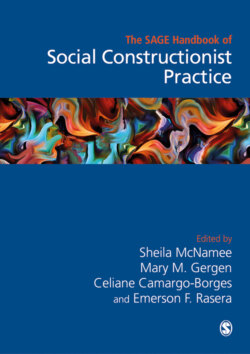Читать книгу The Sage Handbook of Social Constructionist Practice - Группа авторов - Страница 79
На сайте Литреса книга снята с продажи.
The Constructionist Turn
ОглавлениеIt is during this same historical period –sometimes heralded as postmodern – that dialogues on the social construction of knowledge also erupted. One central idea within these dialogues was that our understandings of what we call reality emerge from relationships among people, especially through language and other meaningful activities (see Chapter 1). It is through relational processes – situated within particular historical cultural and physical contexts – that our understandings are created and stabilized (or not), and through which we come to trust one another (or not) as knowable entities acting in what we see as reasonable ways (Gergen, 1994).
From this point of view, there is no group of people that can make claims to transcendent truth, that is truth beyond what anyone might think or wish. There may be multiple and competing claims to what is the case, each legitimate within a socio-historical context. Importantly, this applies as well to the sciences. Scientific descriptions are constructed within sub-cultures of scientists, and serve their particular purposes and values. This is not to say that all descriptions are equal, but rather, to ask what purposes and values are served by their work. Thus, if one agrees with the assumptions and values of Western medicine, one can legitimately compare the outcomes with various indigenous forms of medicine. Yet there are also reasons to question the assumptions and values. The question thus emerges, what are the aims and purposes of the social sciences? What do they value, and how are these values fulfilled by their forms of research and their languages of description and explanation? Often it is said that the aims of the sciences are ‘prediction and control.’ However, many researchers are alienated by this conclusion, and prefer to cast their work, for example, in the service of various liberal and humanitarian goals. We are then invited to ask: what methods, what forms of inquiry, and what forms of description and explanation may best suit such ends.
From these constructionist dialogues emerged three significant conclusions linking the social sciences with the arts. First, by removing the mantle of authority from traditional empirical science, social sciences were liberated to consider alternative methods of inquiry. One may trace the mushrooming of qualitative research practices – including the performative – to this line of argument. Second, because all accounts of the world- including the scientific – carry the values of those who espouse them, then social science researchers can make no claims to value neutrality. The door now opens to carrying out science not as neutral bystanders, but for the very purposes of realizing social and political ends. Finally, from a constructionist perspective, there is no privileged form of language for describing and explaining the world. Thus, in terms of truth posits, the various languages of the arts are equivalent to the languages (and statistics) of the sciences.
While the enormous range of performative and arts-based inquiry that subsequently emerged within the social sciences cannot be traced directly to these ideas, the indirect effects cannot be overestimated. Until such ideas began to ripple through the social sciences, there was no way to legitimate such inquiry. One could look back at many experiments created by social psychologists in the late 1960s and early 1970s as performative in character. For example, Stanley Milgram's (1974) famous studies on obedience, along with the well-known ‘Stanford prison study’ (Haney et al., 1973) were highly theatrical. However, the performativity was inadvertent, as the primary intention was to create empirically grounded generalizations.
More directly related, in my experience were a series of highly popular symposia presented at the American Psychological Association meetings from 1995 to 1999. Presentations included plays, poetry, film, painting, dance, mime, and multi-media presentations. Similarly important were the annual meetings of the International Conference on Qualitative Inquiry, hosted by Norman Denzin at the University of Illinois. Since 2005 they provided an inviting platform for performative work. Attracting over a thousand international researchers a year in the qualitative field, they highlighted the work of many well-known performance scholars, including Tami Spry (2001, 2011), Laurel Richardson (1997), Ron Pelias (1999, 2014, 2018) and Johnny Saldaña (2011).Also noteworthy in the direct linkages with constructionist ideas was the compilation by Kip Jones et al. (2008) in an edited issue of Forum: Qualitative Social Research (vol. 9), This special issue included 42 entries from authors in 13 countries, and featured 100 photographs, 50 illustrations, 36 videos, and two audio-recordings. Jones also was the organizer of a series of five exploratory conferences in 2006–07. These efforts allowed social scientists to identify areas of possible connections with each other as well as with practitioners from the arts (Gergen and Jones, 2008). Jones continues to advance performative social science through his blog Kipworld (2017), and his work at the Bournemouth University, Centre for Qualitative Research.
